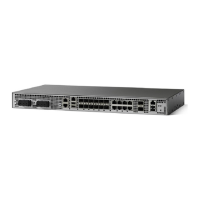PurposeCommand or Action
Example:
Device> enable
•
Enter your password if prompted.
Enters global configuration mode.configure terminal
Example:
Device# configure terminal
Step 2
Configures a T1 or E1 controller and enters controller configuration mode.
controller {t1 | e1} slot/port
Step 3
Example:
Device# controller t1 0/0/1
•
The t1 keyword indicates a T1 line card.
•
The e1 keyword indicates an E1 line card.
•
The slot/port arguments are the backplane slot number and port number
on the interface. Refer to your hardware installation manual for the
specific slot numbers and port numbers.
Defines the time slots that belong to each T1 or E1 circuit.
channel-group channel-number
timeslots fulltimeslots
Step 4
•
The channel-number argument is the channel-group number. When a
T1 data line is configured, channel-group numbers can be values from
Example:
Device(config-controller)#
channel-group 1 timeslots 1-24
1 to 24. When an E1 data line is configured, channel-group numbers
can be values from 1 to 31.
•
The timeslots fulltimeslots keyword and argument specifies time slots.
For a T1 controller, the time slot is 1-24. For an E1 controller the time
slot is 1-31.
Returns to global configuration mode.exit
Example:
Device(config-controller)# exit
Step 5
Configures a serial interface for a Cisco 7500 series router with channelized
T1 or E1 and enters interface configuration mode.
interface serial slot/subslot / port :
channel-group
Step 6
Example:
Device(config)# interface serial
0/0/1:1
•
The slot argument indicates the slot number. Refer to the appropriate
hardware manual for slot and port information.
•
The /port argument indicates the port number. Refer to the appropriate
hardware manual for slot and port information.
•
The :channel-group argument indicates the channel group number.
Cisco 7500 series routers specify the channel group number in the range
of 0 to 4 defined with the channel-group controller configuration
command.
MPLS Basic Configuration Guide, Cisco IOS XE Everest 16.5.1 (Cisco ASR 900 Series)
54
MPLS Multilink PPP Support
Assigning an Interface to a Multilink Bundle

